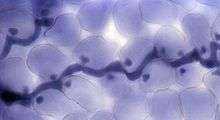Haustorium

In botany and mycology, a haustorium (plural haustoria) is the appendage or portion of a parasitic fungus (the hyphal tip) or of the root of a parasitic plant (such as the broomrape family or mistletoe) that penetrates the host's tissue and draws nutrients from it. Haustoria penetrate the host plant's cell wall and siphon nutrients from the space between the cell wall and plasma membrane but do not penetrate the plant's cell membrane itself.[1]
Fungi in all major divisions form haustoria. Haustoria take several forms. Generally, on penetration, the fungus increases the surface area in contact with host plasma membrane releasing enzymes that break down the cell wall, enabling greater potential movement of organic carbon from host to fungus. Thus, an insect hosting a parasitic fungus such as Cordyceps may look as though it is being "eaten from the inside out" as the haustoria expand inside of it.
Functional exchange takes place within the haustorial complex. The host supplies organic carbon to the fungus, and the metabolic activity within the complex is considerably greater than outside. Carbon from the host is absorbed by the fungus, and transported to the rest of the thallus. The host plant appears to be functioning according to signals from the fungus and the complex appears to be under the control of the invader.[2]
The haustorium may be mycelium or root-shaped.
References
- P.M. Kirk; P.F. Cannon; D.W. Minter; J.A. Stalpers (30 November 2008). Dictionary of the Fungi. CABI. p. 306. ISBN 978-0-85199-826-8. Retrieved 25 October 2012.
Notes
- ↑ Szabo, Les (July 3, 2001). "Hidden robbers: The role of fungal haustoria in parasitism of plants". PNAS. 98 (14): 7654–7655. doi:10.1073/pnas.151262398. Retrieved 19 April 2015.
- ↑ Mycology - Structure and Function - Haustoria